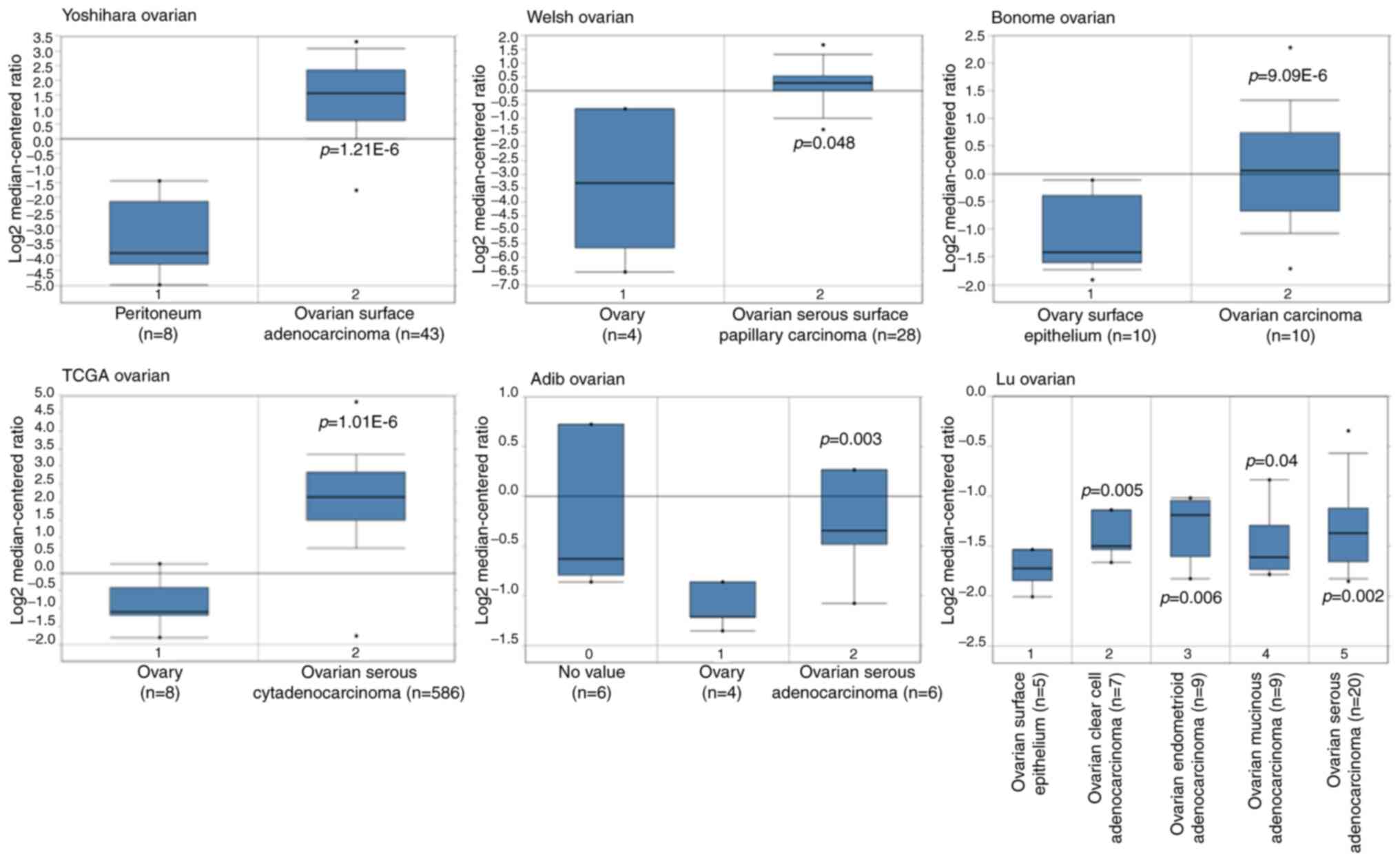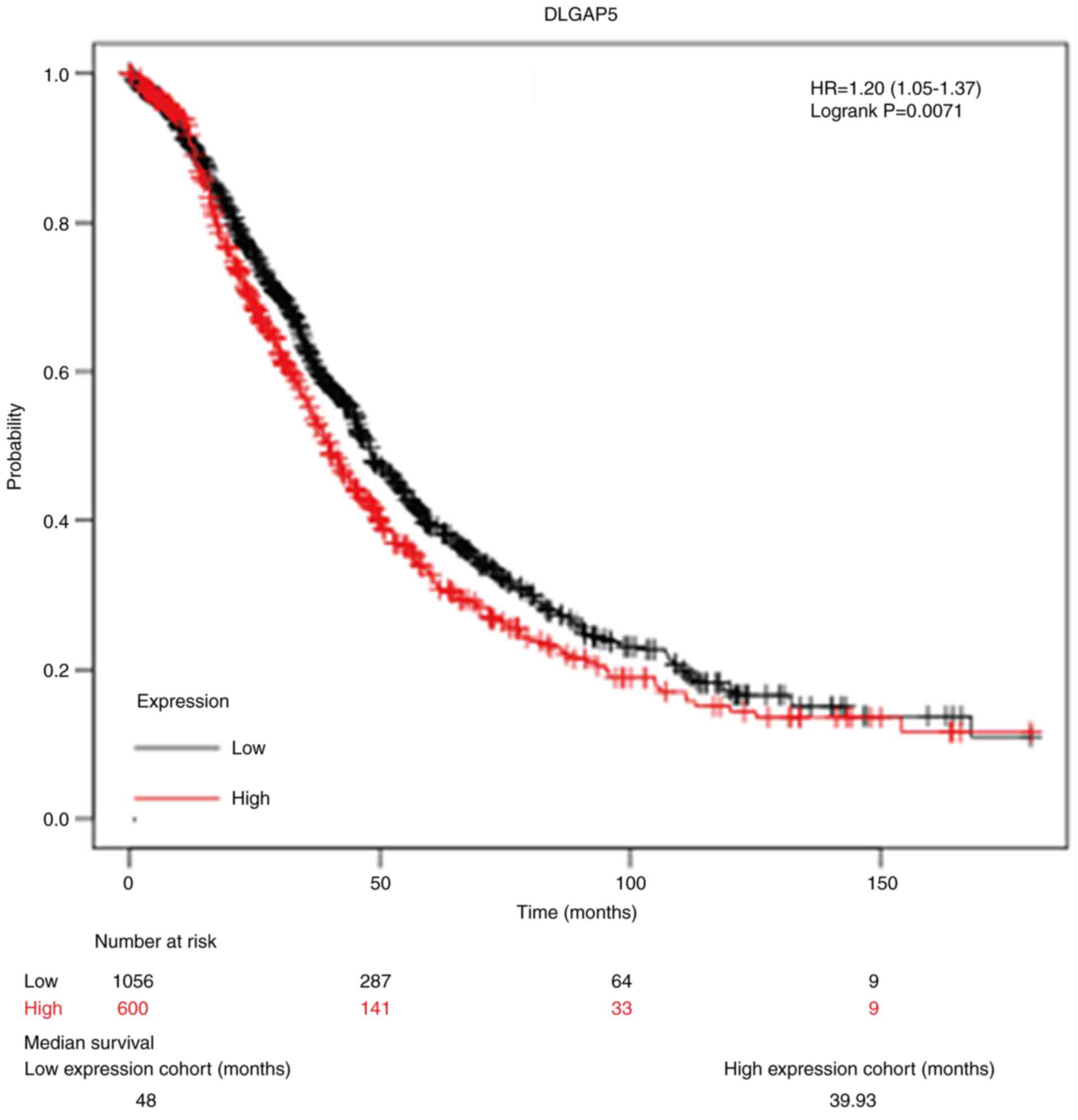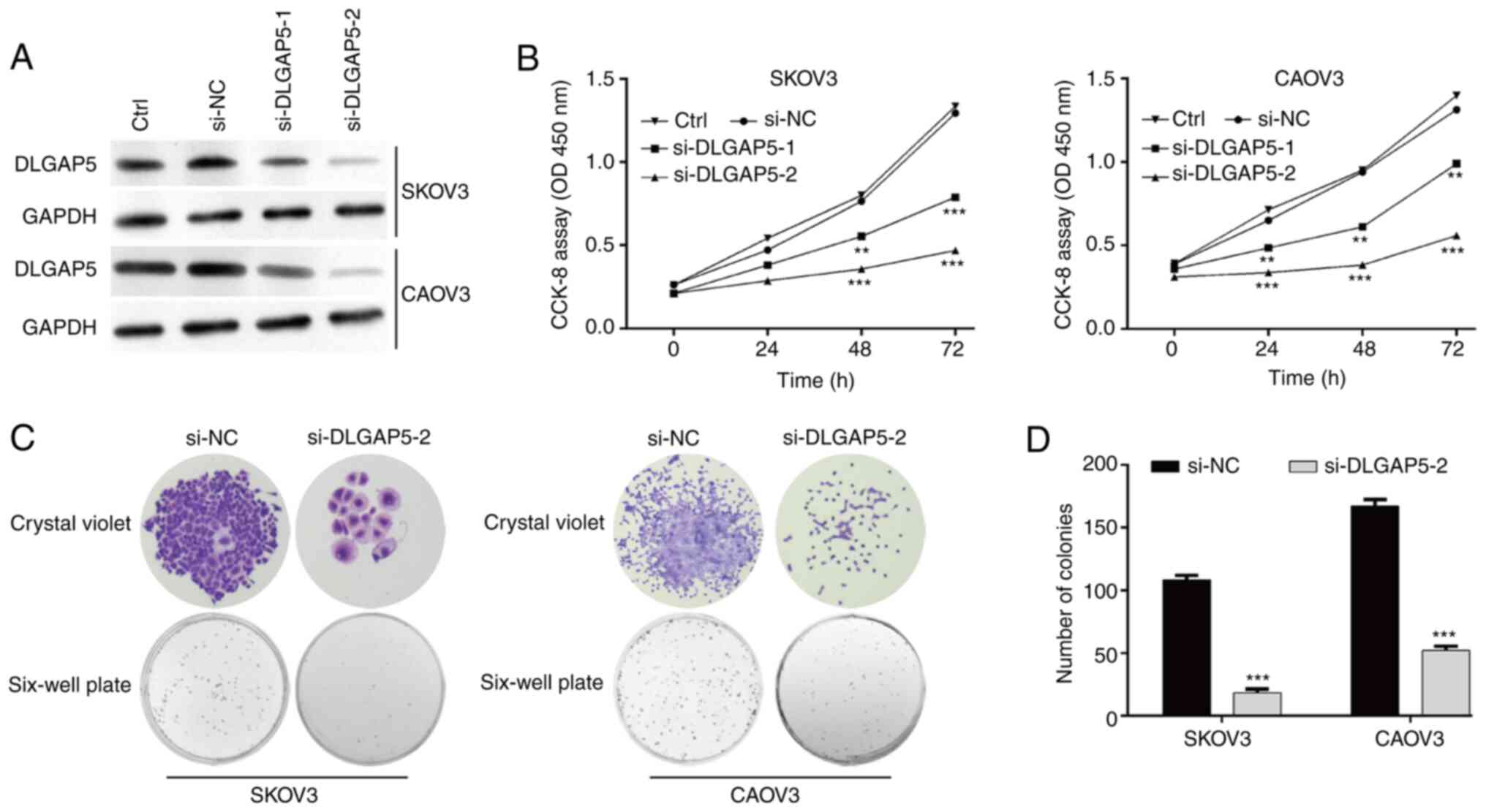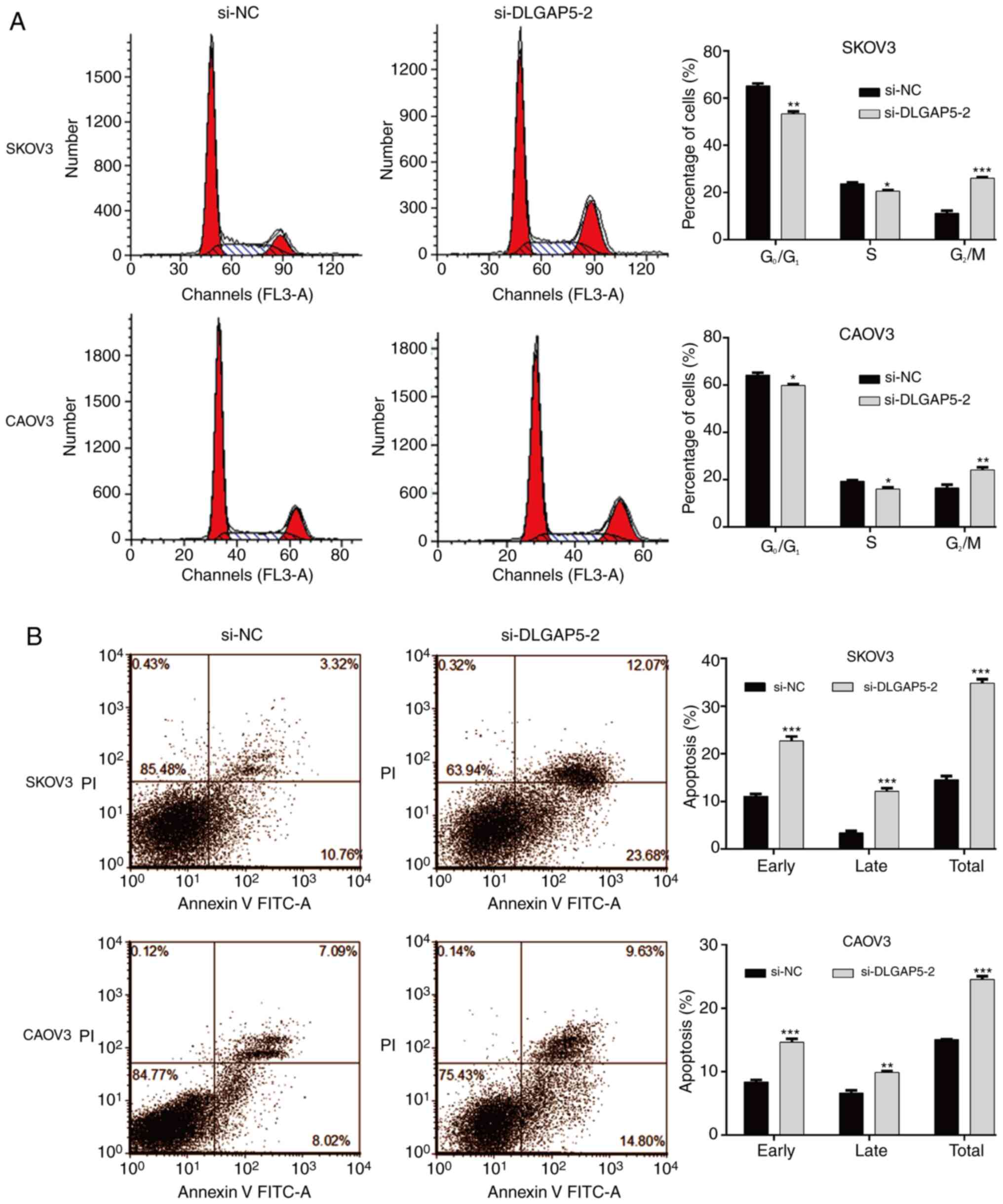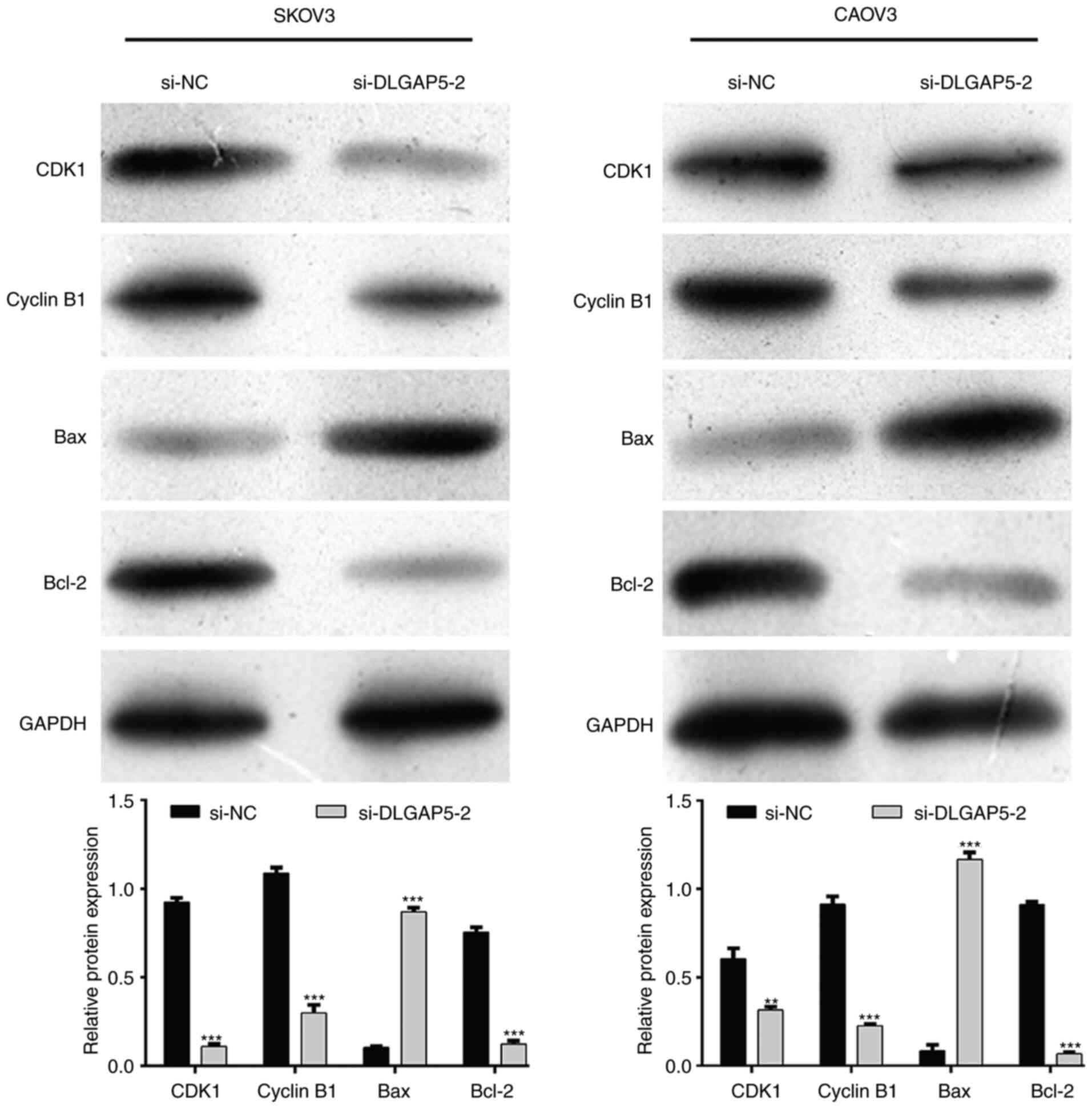Knockdown of DLGAP5 suppresses cell proliferation, induces G2/M phase arrest and apoptosis in ovarian cancer
- Authors:
- Published online on: September 2, 2021 https://doi.org/10.3892/etm.2021.10680
- Article Number: 1245
-
Copyright: © Zhang et al. This is an open access article distributed under the terms of Creative Commons Attribution License.
Abstract
Introduction
Ovarian cancer (OC) is one of the leading causes of tumor-associated deaths and most common gynecological malignancies (1). Current standard treatments, including surgery and adjuvant chemotherapy or radiotherapy, have made significant improvements in diagnosing and treating OC (2). However, the prognosis is still unfavorable, especially for patients with OC at advanced stage when first diagnosed. It has been widely accepted that OC pathogenesis is accompanied by malignant uncontrolled proliferation, extensive invasion and lymphatic metastasis, which is regulated by aberrantly expressed genes (3,4). Consequently, there is a great need for research to elucidate the molecular mechanisms associated with OC pathogenesis to help improve the patient outcomes.
The family of discs large-associated protein (DLGAP) composed of five members (DLGAP1-5) were originally found in rats, which have three key domains, including a 14-amino-acid repeat domain (5), a dynein light chain domain (6) and a guanylate kinase-associated protein homology domain (7). DLGAP1-4 have been reported to participate in a variety of neurological disorders, such as cerebellar ataxia, obsessive compulsive disorder and autism spectrum disease (8-10). In the present study, DLGAP5 (also named as HURP or KIAA0008) is of great interest for it is mainly associated with to various types of cancer (11-13). For instance, DLGAP5 was identified as a cycle cycle-related gene associated with long-term in vitro proliferation in patients with acute myeloid leukemia (14). Bioinformatics analysis by different investigators indicated that DLGAP5 was correlated with poor prognosis in anaplastic thyroid carcinoma (15), non-small cell lung cancer (16,17), pancreatic carcinoma (18) and glioblastoma (19). Loss-of-functional experiments showed that DLGAP5 could promote cell growth, proliferation and migration in hepatocellular carcinoma (20,21). Notably, Liu et al (22) and Shen et al (23) consistently showed that DLGAP5 was aberrantly expressed and correlated with prognosis in OC. Nevertheless, the biological function of DLGAP5 in OC still has not been reported yet.
Therefore, the present study first searched the Oncomine microarray database (http://www.oncomine.org) and Kaplan-Meier Plotter (http://kmplot.com/analysis/) to investigate the expression pattern and prognostic value of DLGAP5 in OC. By performing loss-of-functional assays, the effects of DLGAP5 on cell proliferation, cell cycle progression and apoptosis was further explored in OC cells. The findings of the present study might provide evidence that targeting DLGAP5 could be a promising therapeutic strategy in OC.
Materials and methods
Oncomine gene expression analysis
The expression of DLGAP5 in OC was analyzed using publicly available Oncomine microarray database (http://www.oncomine.org) by searching the following key words: Gene name, DLGAP5; primary filter, ‘Cancer vs. Normal Analysis’; and cancer type ‘Ovarian cancer’. A total of six datasets, including Yoshihara Ovarian (24), Welsh Ovarian (25), Bonome Ovarian (26), The Cancer Genome Atlas (TCGA, http://tcga-data.nci.nih.gov/tcga/), Adib Ovarian (27) and Lu Ovarian (28) were screened to compare the expression pattern of DLGAP5 between OC tissues with normal tissues. The DLGAP5 expression data were log-transformed and median-centered per array with normalized standard deviation (SD).
Kaplan-Meier plotter analysis
The prognostic value of DLGAP5 was further evaluated in OC using Kaplan-Meier Plotter (http://kmplot.com/analysis/), a database that contains information on 22,277 genes and their effect on survival in 2,977 breast, 1,464 ovarian and 1,715 patients with lung cancer. In the present study, patients with OC and complete overall survival information were classified into high and low DLGAP5 expression groups. The effects of DLGAP5 on overall survival rate were displayed using a Kaplan-Meier survival plot. Meanwhile, the hazard ratio was calculated with 95% confidence intervals, log rank P-value and median survival time.
Cell culture and transfection
Two human OC cell lines, including SKOV3 and CAOV3 were purchased from the American Type Culture Collection and routinely cultured in RPMI-1640 medium (Sigma-Aldrich; Merck KGaA) supplemented with 10% FBS (Sigma-Aldrich; Merck KGaA) at 37˚C in a humidified incubator containing 5% CO2. For DLGAP5 knockdown, SKOV3 and CAOV3 cell were seeded into six-well plates at a density of 2x105 cells per well and transfected with 50 nM small interfering (si)RNA targeting DLGAP5 (si-DLGAP5-1: 5'-ATTCAAACCACATCAGCCTGC-3' or si-DLGAP5-2: 5'-TTGACCGGAGAAGATAGAGGA-3') or negative control (si-NC: 5'-GAAACACAGCCTGTACGCCTG-3') (all chemically synthesized from Shanghai GenePharma Co., Ltd.) using Lipofectamine® 2000 reagent (Invitrogen; Thermo Fisher Scientific, Inc.) according to the manufacturer's protocol. Subsequent experiments were performed 48 h post transfection.
Cell counting kit-8 (CCK-8) assay
Transfected cells were seeded in a 96-well plate at a density of 3,000 cells per and cultured overnight. At 24, 48 and 72 h, cells in each well were incubated with 10 µl CCK-8 solution (Biosharp Life Sciences) for 2 h at 37˚C. Absorbance at 450 nm was recorded using a microplate reader. Each sample was performed in triplicate.
Colony-formation assay
Transfected cells were plated in six-well culture plates at 500 cells per well and cultured to attach for 24 h. After incubation for 14 consecutive days at 37˚C, naturally formed colonies were fixed for 30 min on ice with 70% ethanol and stained with 0.1% crystal violet for 15 min at room temperature. Images of the colonies (each colony contains at least 50 cells) were captured and counted in five randomly selected fields under a light microscope (magnification, x25). Each sample was performed in triplicate.
Flow cytometry analysis
Transfected cells were harvested by trypsinization, washed with cold PBS and fixed with 70% cold ethanol for 30 min at ice. For cell cycle analysis, fixed cells were washed and stained with propidium iodide (PI)/RNase A solution (BD Biosciences) in darkness for 30 min at 37˚C. Stained cells were applied for cell cycle distribution analysis using a FACSCalibur flow cytometer (BD Biosciences). For apoptosis analysis, fixed cells were stained with Annexin V-fluorescein isothiocyanate/PI apoptosis detection (BD Biosciences), followed by flow cytometry analysis according to the manufacturer's instructions. Data were analyzed using FlowJo™ v.10.8 software (FlowJo, LLC).
Western blot analysis
All protein samples were extracted and the corresponding protein concentration were determined according to the instructions of RIPA lysis buffer and BCA protein assay provided by Beyotime Institute of Biotechnology, respectively. Next, protein samples (30 µg/lane) were separated on 12% SDS-PAGE gel and transferred onto polyvinylidene fluoride membranes. After conventional blocking with 5% skimmed non-fat dry milk (Cell Signaling Technology, Inc.) for 2 h at room temperature, the membranes were incubated overnight at 4˚C with primary antibodies against CDK1 (1:1,000; cat. no. ab131450; Abcam), Cyclin B1 (1:1,000; cat. no. 4138; Cell Signaling Technology, Inc.), Bax (1:1,000; cat. no. 2772; Cell Signaling Technology, Inc.), Bcl-2 (1:1,000; cat no. sc-7382; Santa Cruz Biotechnology Inc.) and GAPDH (1:1,000; cat. no. G9545; Sigma-Aldrich; Merck KGaA) at 4˚C, followed by incubation with secondary antibody conjugated to horseradish peroxidase (1:5,000; cat. no. sc-2357; Santa Cruz Biotechnology, Inc.) for 2 h at room temperature. The protein bands were visualized with an enhanced chemiluminescence substrate (Beyotime Institute of Biotechnology). Results of western blots were analyzed using ImageLab software version 4.1 (Bio-Rad Laboratories, Inc.).
Statistical analysis
Data were analyzed using GraphPad Prism 6.0 (GraphPad Software, Inc.) and expressed as mean ± SD of three independent experiments. One way ANOVA followed by the post hoc Tukey's HSD test was used to assess the differences among different groups. The Renyi test was used for analyzing survival curves. P<0.05 was used to indicate a statistically significant difference.
Results
DLGAP5 expression in human OC
In order to obtain the expression pattern of DLGAP5 in OC, multiple cancer microarray data sets available from Oncomine database were downloaded to determine the differential mRNA expression of DLGAP5 between OC tissues and normal tissues. As shown in Fig. 1, the mRNA expression of DLGAP5 was markedly increased in OC tissues, including epithelium OC (for example, serous, endometrioid, mucinous and clear cell subtypes) vs. normal tissues in the Yoshihara Ovarian dataset (P=1.21x106), Welsh Ovarian dataset (P=0.048), Bonome Ovarian dataset (P=9.09E-6), TCGA database, (P=1.01E-6), Adib Ovarian dataset (P=0.003) and Lu Ovarian dataset (P<0.05). The aforementioned observations highlighted the overexpression of DLGAP5 in the development of OC.
Prognostic value of DLGAP5 in OC
Next, the focus was on the survival information of patients with OC to analyze the prognostic value of DLGAP5 using online Kaplan-Meier analysis. As depicted in Fig. 2, 1,656 patients with OC were divided into high DLGAP5 expression group (n=600) and low DLGAP5 expression group (n=1,056) according to the median value of DLGAP5 expression. Kaplan-Meier survival curve analysis showed that high expression of DLGAP5 was negatively associated with overall survival (HR=1.20, 95% CI: 1.05-1.37, P=0.0071). The median survival in the low expression group and high expression group was 48 and 39.93 months, respectively.
Knockdown of DLGAP5 significantly suppresses cell proliferation in OC cells
Considering the overexpression of DLGAP5 in OC tissues, loss-of-functional experiments were subsequently performed to investigate the function of DLGAP5 in OC cells. Firstly, two OC cell lines (SKOV3 and CAOV3) were transfected with two different siRNAs targeting DLGAP5. As demonstrated by western blot analysis, both si-DLGAP5-1 and si-DLGAP5-2 caused a notable downregulation in DLGAP5 expression in SKOV3 and CAOV3 cells compared with si-NC transfection, while there was no significant change in DLGAP5 expression between control and si-NC group (Fig. 3A). Furthermore, si-DLGAP5-2 transfection caused stronger suppressive effects on DLGAP5 protein expression compared with si-DLGAP5-1 transfection. CCK-8 assay showed that significant inhibition of cell proliferation was observed in SKOV3 (at 48 and 72 h) and CAOV3 (at 24, 48 and 72 h) cells after transfection with either si-DLGAP5-1 or si-DLGAP5-2 compared with si-NC transfection, while there was no significant change in cell proliferation ability between control and si-NC group (Fig. 3B). si-DLGAP5-2 transfection had stronger suppressive effects on the proliferation ability of SKOV3 and CAOV3 cells compared with the effects of si-DLGAP5-1. Thus, si-DLGAP5-2 transfection was selected for the subsequent experiments. Consistent with CCK-8 assay, the number of colonies was significantly decreased in the si-DLGAP5-2 transfection group compared with the si-NC group in both SKOV3 and CAOV3 cells (Fig. 3C and D). The aforementioned data indicated that DLGAP5 might be an oncogene by promoting cell proliferation in OC.
Knockdown of DLGAP5 causes G2/M phase arrest and apoptosis in OC cells
Subsequently, the effects of DLGAP5 knockdown on cell cycle progression and apoptosis was studied by flow cytometry analysis. As shown in Fig. 4A, the percentage of cells at G0/G1 and S phases was significantly decreased, accordingly accompanied with increased cell proportion at G2/M phase in si-DLGAP5-2 group compared with the si-NC group in SKOV3 and CAOV3 cells, which indicated that knockdown of DLGAP5 caused cell cycle G2/M phase arrest. Moreover, it was found that knockdown of DLGAP5 remarkedly increased the early, late and overall apoptotic cells in both SKOV3 and CAOV3 cells (Fig. 4B).
Knockdown of DLGAP5 regulates the protein expression levels associated with G2/M transition and apoptosis
To explore the mechanisms underlying DLGAP5 regulating cell cycle progression and apoptosis, the expression levels of major cell cycle-promoting factors and apoptosis regulatory factors were analyzed. As shown in Fig. 5, the expression of CDK1 and Cyclin B1, associated with the G2/M checkpoint, was notably downregulated after DLGAP5 knockdown in both SKOV3 and CAOV3 cells. Meanwhile, DLGAP5 knockdown activated the pro-apoptotic Bax, while suppressing the anti-apoptotic Bcl-2 expression in both SKOV3 and CAOV3 cells.
Discussion
In the present study, DLGAP5 expression was found to be significantly overexpressed in OC tissues and negatively associated with overall survival in patients with OC by bioinformatics analysis. The Lu Ovarian dataset in Fig. 1 demonstrated that the mRNA expression of DLGAP5 was different between mucinous OC and serous, endometrioid and clear cell OC, of which endometrioid OC presented higher DLGAP5 mRNA expression. The present study focused on the expression of DLGAP5 or prognosis in tumor tissues; however, more clinical samples should be collected to confirm this. In fact, DLGAP5 has been reported to be upregulated in hepatocellular cancer (13,29), urinary bladder transitional cell carcinoma (30) and transitional cell carcinoma (31). Consistent with the bioinformatic analysis, DLGAP5 was identified and validated as one of the most upregulated genes regulating cell division and mitotic spindle formation in ovarian granulosa cells with cancer-like characteristics (32). DLGAP5 was also screened as a hub gene and was associated with the prognosis of endometrial carcinoma (33). Interestingly, the Gene Expression Omnibus database showed that DLGAP5 was one of the core gene with more than ten degrees in epithelial OC (22). GEPIA database analysis indicated that DLGAP5 was highly expressed in OC specimens and was associated with worse prognosis (23). Furthermore, DLGAP5 was overexpressed and associated with worse overall survival in distinct molecular colorectal cancer subtypes (34). The aforementioned evidences suggested that DLGAP5 might be candidate target for the diagnosis and treatment of OC.
Next, two OC cell lines (SKOV3 and CAOV3) were selected to investigate the biological function of DLGAP5, by successfully constructing DLGAP5-silenced OC cell lines. Two different siRNAs targeting DLGAP5 (si-DLGAP5-1 and si-DLGAP5) were designed to knockdown DLGAP5 expression and it was found that si-DLGAP5-2 transfection caused stronger suppressive effects on DLGAP5 protein expression compared with si-DLGAP5-1 transfection. Notably, si-DLGAP5-2 transfection had stronger suppressive effects on the proliferation ability of SKOV3 and CAOV3 cells compared with si-DLGAP5-1 transfection. The differences in knockdown efficiency between si-DLGAP5-2 and si-DLGAP5-1 are ascribed to the different sequences designed for targeting DLGAP5 and different response of OC cells to the designed sequences. It was further found that knockdown of DLGAP5 significantly suppressed colony formation, induced cell cycle G2/M phase arrest and apoptosis in OC cells. At the molecular level, it was further demonstrated that knockdown of DLGAP5 downregulated the expression of CDK1, Cyclin B1 and Bcl-2, while upregulating Bax expression in both SKOV3 and CAOV3 cells. To the best of our knowledge, normal cell cycle regulation comprised of G0/G1, S, G2/M stages requires the balance of growth factors and growth inhibitor factors, while its deregulation often causes uncontrolled malignant proliferation involved in the pathogenesis of tumors (35,36). DLGAP5, as a microtubule-associated protein, promotes spindle formation (37), novel tubulin sheet formation (38) and the capture of spindle by kinetochore (39). Associated studies indicated that DLGAP5 is periodically changed as the cells progress from M to G0/G phase, whose degradation could be modulated by CDK1/Cyclin B (40,41). Through GSEA analysis, Zhang et al (42) found that DLGAP5 is involved in the G1/S phase transition and M/G1 transition. In addition, DLGAP5 participated in the NUSAP1 knockdown downregulating the expression of genes associated with G2/M phase, including CDK1 expression in invasive breast cancer cells (42). Liao et al (20) also reported that the silencing of DLGAP5 gene expression by RNA interference significantly suppressed cell growth and colony formation in vitro in hepatocellular carcinoma cells. Based on the aforementioned facts, one might speculate that knockdown of DLGAP5 inhibited cell proliferation by inducing G2/M phase arrest via downregulating CDK1/Cyclin B1 expression in OC cells. Meanwhile, it was found that the knockdown of DLGAP5 promoted apoptotic cells by regulating Bax and Bcl-2 expression levels. Similarly, Kuo et al (21) indicated that knockdown of DLGAP5 sensitized SK-Hep-1 cells to cisplatin and resulted in smaller tumors in nude mice via promoting apoptosis in hepatocellular carcinoma. The overexpression of DLGAP5 suppressed γ-irradiation-induced apoptosis in prostate cancer cells (43).
In conclusion, it was revealed that DLGAP5 was overexpressed in OC tissues and predicted poor prognosis in patients with OC. The potential mechanisms of DLGAP5 in facilitating OC cell proliferation via regulating G2/M phase and apoptosis was also demonstrated, suggesting that DLGAP5 might be a potential therapeutic target of OC. In addition, some limitations of the present study were as follows: A non-cancerous cell line as a normal/negative control was not used in the present study. DLGAP5 expression will be analyzed in clinical samples by immunohistochemistry, and the association between DLGAP5 expression and the prognosis of ovarian cancer will be determined in subsequent investigations.
Acknowledgements
Not applicable.
Funding
Funding: This study was sponsored by the Hubei Natural Science Foundation (grant no. 2017 CFB335).
Availability of data and materials
The datasets used and/or analyzed during the current study are available from the corresponding author on reasonable request.
Authors' contributions
HZ designed the study, performed the experiments and made substantial contributions to the conception of this work. YL performed the experiments and assessed the literature. ST and XQ collected the data and were involved in drafting the manuscript or revising it critically for important intellectual content. LL and JTZ analyzed the data. JZ and BL performed the experiments and gave suggestions for the revision of this manuscript. HZ and JZ confirmed the authenticity of all the raw data and designed this work. All authors read and approved the final manuscript.
Ethics approval and consent to participate
Not applicable.
Patient consent for publication
Not applicable.
Competing interests
The authors declare that they have no competing interests.
References
|
Lheureux S, Braunstein M and Oza AM: Epithelial ovarian cancer: Evolution of management in the era of precision medicine. CA Cancer J Clin. 69:280–304. 2019.PubMed/NCBI View Article : Google Scholar | |
|
Reid BM, Permuth JB and Sellers TA: Epidemiology of ovarian cancer: A review. Cancer Biol Med. 14:9–32. 2017.PubMed/NCBI View Article : Google Scholar | |
|
Smith RA, Andrews KS, Brooks D, Fedewa SA, Manassaram-Baptiste D, Saslow D, Brawley OW and Wender RC: Cancer screening in the United States, 2018: A review of current American cancer society guidelines and current issues in cancer screening. CA Cancer J Clin. 68:297–316. 2018.PubMed/NCBI View Article : Google Scholar | |
|
Han CY, Patten DA, Richardson RB, Harper ME and Tsang BK: Tumor metabolism regulating chemosensitivity in ovarian cancer. Genes Cancer. 9:155–175. 2018.PubMed/NCBI View Article : Google Scholar | |
|
Sabio G, Arthur JS, Kuma Y, Peggie M, Carr J, Murray-Tait V, Centeno F, Goedert M, Morrice NA and Cuenda A: p38gamma regulates the localisation of SAP97 in the cytoskeleton by modulating its interaction with GKAP. EMBO J. 24:1134–1145. 2005.PubMed/NCBI View Article : Google Scholar | |
|
Naisbitt S, Valtschanoff J, Allison DW, Sala C, Kim E, Craig AM, Weinberg RJ and Sheng M: Interaction of the postsynaptic density-95/guanylate kinase domain-associated protein complex with a light chain of myosin-V and dynein. J Neurosci. 20:4524–4534. 2000.PubMed/NCBI View Article : Google Scholar | |
|
Tong J, Yang H, Eom SH, Chun C and Im YJ: Structure of the GH1 domain of guanylate kinase-associated protein from Rattus norvegicus. Biochem Biophys Res Commun. 452:130–135. 2014.PubMed/NCBI View Article : Google Scholar | |
|
Minocherhomji S, Hansen C, Kim HG, Mang Y, Bak M, Guldberg P, Papadopoulos N, Eiberg H, Doh GD, Møllgård K, et al: Epigenetic remodelling and dysregulation of DLGAP4 is linked with early-onset cerebellar ataxia. Hum Mol. 23:6163–6176. 2014.PubMed/NCBI View Article : Google Scholar | |
|
Ryu S, Oh S, Cho EY, Nam HJ, Yoo JH, Park T, Joo YH, Kwon JS and Hong KS: Interaction between genetic variants of DLGAP3 and SLC1A1 affecting the risk of atypical antipsychotics-induced obsessive-compulsive symptoms. Am J Med Genet B Neuropsychiatr Genet. 156B:949–959. 2011.PubMed/NCBI View Article : Google Scholar | |
|
Kajimoto Y, Shirakawa O, Lin XH, Hashimoto T, Kitamura N, Murakami N, Takumi T and Maeda K: Synapse-associated protein 90/postsynaptic density-95-associated protein (SAPAP) is expressed differentially in phencyclidine-treated Rats and is increased in the nucleus accumbens of patients with schizophrenia. Neuropsychopharmacology. 28:1831–1839. 2003.PubMed/NCBI View Article : Google Scholar | |
|
Tang ZY, Ye SL, Liu YK, Qin LX, Sun HC, Ye QH, Wang L, Zhou J, Qiu SJ, Li Y, et al: A decade's studies on metastasis of hepatocellular carcinoma. J Cancer Res Clin Oncol. 130:187–196. 2004.PubMed/NCBI View Article : Google Scholar | |
|
Stangeland B, Mughal AA, Grieg Z, Sandberg CJ, Joel M, Nygård S, Meling T, Murrell W, Vik Mo EO and Langmoen IA: Combined expressional analysis, bioinformatics and targeted proteomics identify new potential therapeutic targets in glioblastoma stem cells. Oncotarget. 6:26192–26215. 2015.PubMed/NCBI View Article : Google Scholar | |
|
Tsou AP, Yang CW, Huang CY, Yu RC, Lee YC, Chang CW, Chen BR, Chung YF, Fann MJ, Chi CW, et al: Identification of a novel cell cycle regulated gene, HURP, overexpressed in human hepatocellular carcinoma. Oncogene. 22:298–307. 2003.PubMed/NCBI View Article : Google Scholar | |
|
Hatfield KJ, Reikvam H and Bruserud O: Identification of a subset of patients with acute myeloid leukemia characterized by long-term in vitro proliferation and altered cell cycle regulation of the leukemic cells. Expert Opin Ther Targets. 18:1237–1251. 2014.PubMed/NCBI View Article : Google Scholar | |
|
Weinberger P, Ponny SR, Xu H, Bai S, Smallridge R, Copland J and Sharma A: Cell cycle M-phase genes are highly upregulated in anaplastic thyroid carcinoma. Thyroid. 27:236–252. 2017.PubMed/NCBI View Article : Google Scholar | |
|
Schneider MA, Christopoulos P, Muley T, Warth A, Klingmueller U, Thomas M, Herth FJ, Dienemann H, Mueller NS, Theis F and Meister M: AURKA, DLGAP5, TPX2, KIF11 and CKAP5: Five specific mitosis-associated genes correlate with poor prognosis for non-small cell lung cancer patients. Int J Oncol. 50:365–372. 2017.PubMed/NCBI View Article : Google Scholar | |
|
Shi YX, Yin JY, Shen Y, Zhang W, Zhou HH and Liu ZQ: Genome-scale analysis identifies NEK2, DLGAP5 and ECT2 as promising diagnostic and prognostic biomarkers in human lung cancer. Sci Rep. 7(8072)2017.PubMed/NCBI View Article : Google Scholar | |
|
Zhou Z, Cheng Y, Jiang Y, Liu S, Zhang M, Liu J and Zhao Q: Ten hub genes associated with progression and prognosis of pancreatic carcinoma identified by co-expression analysis. Int J Biol Sci. 14:124–136. 2018.PubMed/NCBI View Article : Google Scholar | |
|
Zhou Y, Yang L, Zhang X, Chen R, Chen X, Tang W and Zhang M: Identification of potential biomarkers in glioblastoma through bioinformatic analysis and evaluating their prognostic value. Biomed Res Int. 2019(6581576)2019.PubMed/NCBI View Article : Google Scholar | |
|
Liao W, Liu W, Yuan Q, Liu X, Ou Y, He S, Yuan S, Qin L, Chen Q, Nong K, et al: Silencing of DLGAP5 by siRNA significantly inhibits the proliferation and invasion of hepatocellular carcinoma cells. PLoS One. 8(e80789)2013.PubMed/NCBI View Article : Google Scholar | |
|
Kuo TC, Chang PY, Huang SF, Chou CK and Chao CC: Knockdown of HURP inhibits the proliferation of hepacellular carcinoma cells via downregulation of gankyrin and accumulation of p53. Biochem Pharmacol. 83:758–768. 2012.PubMed/NCBI View Article : Google Scholar | |
|
Liu J, Meng H, Li S, Shen Y, Wang H, Shan W, Qiu J, Zhang J and Cheng W: Identification of potential biomarkers in association with progression and prognosis in epithelial ovarian cancer by integrated bioinformatics analysis. Front Genet. 10(1031)2019.PubMed/NCBI View Article : Google Scholar | |
|
Shen J, Yu S, Sun X, Yin M, Fei J and Zhou J: Identification of key biomarkers associated with development and prognosis in patients with ovarian carcinoma: Evidence from bioinformatic analysis. J Ovarian Res. 12(110)2019.PubMed/NCBI View Article : Google Scholar | |
|
Yoshihara K, Tajima A, Komata D, Yamamoto T, Kodama S, Fujiwara H, Suzuki M, Onishi Y, Hatae M, Sueyoshi K, et al: Gene expression profiling of advanced-stage serous ovarian cancers distinguishes novel subclasses and implicates ZEB2 in tumor progression and prognosis. Cancer Sci. 100:1421–1428. 2009.PubMed/NCBI View Article : Google Scholar | |
|
Welsh JB, Zarrinkar PP, Sapinoso LM, Kern SG, Behling CA, Monk BJ, Lockhart DJ, Burger RA and Hampton GM: Analysis of gene expression profiles in normal and neoplastic ovarian tissue samples identifies candidate molecular markers of epithelial ovarian cancer. Proc Natl Acad Sci USA. 98:1176–1181. 2001.PubMed/NCBI View Article : Google Scholar | |
|
Bonome T, Levine DA, Shih J, Randonovich M, Pise-Masison CA, Bogomolniy F, Ozbun L, Brady J, Barrett JC, Boyd J and Birrer MJ: A gene signature predicting for survival in suboptimally debulked patients with ovarian cancer. Cancer Res. 68:5478–5486. 2008.PubMed/NCBI View Article : Google Scholar | |
|
Adib TR, Henderson S, Perrett C, Hewitt D, Bourmpoulia D, Ledermann J and Boshoff C: Predicting biomarkers for ovarian cancer using gene-expression microarrays. Br J Cancer. 90:686–692. 2004.PubMed/NCBI View Article : Google Scholar | |
|
Lu KH, Patterson AP, Wang L, Marquez RT, Atkinson EN, Baggerly KA, Ramoth LR, Rosen DG, Liu J, Hellstrom I, et al: Selection of potential markers for epithelial ovarian cancer with gene expression arrays and recursive descent partition analysis. Clin Cancer Res. 10:3291–3300. 2004.PubMed/NCBI View Article : Google Scholar | |
|
Chang ML, Lin SM and Yeh CT: HURP expression-assisted risk scores identify prognosis distinguishable subgroups in early stage liver cancer. PLoS One. 6(e26323)2011.PubMed/NCBI View Article : Google Scholar | |
|
Huang YL, Chiu AW, Huan SK, Wang YC, Ju JP and Lu CL: Prognostic significance of hepatoma-up-regulated protein expression in patients with urinary bladder transitional cell carcinoma. Anticancer Res. 23:2729–2733. 2003.PubMed/NCBI | |
|
Chiu AW, Huang YL, Huan SK, Wang YC, Ju JP, Chen MF and Chou CK: Potential molecular marker for detecting transitional cell carcinoma. Urology. 60:181–185. 2002.PubMed/NCBI View Article : Google Scholar | |
|
Brązert M, Kranc W, Chermuła B, Kowalska K, Jankowski M, Celichowski P, Jeseta M, Piotrowska-Kempisty H, Pawelczyk L, Zabel M, et al: Human ovarian granulosa cells isolated during an IVF procedure exhibit differential expression of genes regulating cell division and mitotic spindle formation. J Clin Med. 8(2026)2019.PubMed/NCBI View Article : Google Scholar | |
|
Zhang W, Gao L, Wang C, Wang S, Sun D, Li X, Liu M, Qi Y, Liu J and Lin B: Combining bioinformatics and experiments to identify and verify key genes with prognostic values in endometrial carcinoma. J Cancer. 11:716–732. 2020.PubMed/NCBI View Article : Google Scholar | |
|
Branchi V, Garcia SA, Radhakrishnan P, Győrffy B, Hissa B, Schneider M, Reißfelder C and Schölch S: Prognostic value of DLGAP5 in colorectal cancer. Int J Colorectal Dis. 34:1455–1465. 2019.PubMed/NCBI View Article : Google Scholar | |
|
Sterlacci W, Tzankov A, Veits L, Zelger B, Bihl MP, Foerster A, Augustin F, Fiegl M and Savic S: A comprehensive analysis of p16 expression, gene status, and promoter hypermethylation in surgically resected non-small cell lung carcinomas. J Thorac Oncol. 6:1649–1657. 2011.PubMed/NCBI View Article : Google Scholar | |
|
Singhal S, Amin KM, Kruklitis R, DeLong P, Friscia ME, Litzky LA, Putt ME, Kaiser LR and Albelda SM: Alterations in cell cycle genes in early stage lung adenocarcinoma identified by expression profiling. Cancer Biol Ther. 2:291–298. 2003.PubMed/NCBI View Article : Google Scholar | |
|
Santarella RA, Koffa MD, Tittmann P, Gross H and Hoenger A: HURP wraps microtubule ends with an additional tubulin sheet that has a novel conformation of tubulin. J Mol Biol. 365:1587–1595. 2007.PubMed/NCBI View Article : Google Scholar | |
|
Koffa MD, Casanova CM, Santarella R, Köcher T, Wilm M and Mattaj IW: HURP is part of a Ran-dependent complex involved in spindle formation. Curr Biol. 16:743–754. 2006.PubMed/NCBI View Article : Google Scholar | |
|
Casanova CM, Rybina S, Yokoyama H, Karsenti E and Mattaj IW: Hepatoma up-regulated protein is required for chromatin-induced microtubule assembly independently of TPX2. Mol Biol Cell. 19:4900–4908. 2008.PubMed/NCBI View Article : Google Scholar | |
|
Yu CT, Hsu JM, Lee YC, Tsou AP, Chou CK and Huang CY: Phosphorylation and stabilization of HURP by Aurora-A: Implication of HURP as a transforming target of Aurora-A. Mol Cell Biol. 25:5789–5800. 2005.PubMed/NCBI View Article : Google Scholar | |
|
Hsu JM, Lee YC, Yu CT and Huang CY: Fbx7 functions in the SCF complex regulating Cdk1-cyclin B-phosphorylated hepatoma up-regulated protein (HURP) proteolysis by a proline-rich region. J Biol Chem. 279:32592–32602. 2004.PubMed/NCBI View Article : Google Scholar | |
|
Zhang X, Pan Y, Fu H and Zhang J: Nucleolar and spindle associated protein 1 (NUSAP1) inhibits cell proliferation and enhances susceptibility to epirubicin in invasive breast cancer cells by regulating cyclin D kinase (CDK1) and DLGAP5 expression. Med Sci Monit. 24:8553–8564. 2018.PubMed/NCBI View Article : Google Scholar | |
|
Hassan M, El Khattouti A, Ejaeidi A, Ma T, Day WA, Espinoza I, Vijayakumar S and Gomez CR: Elevated expression of hepatoma up-regulated protein inhibits γ-irradiation-induced apoptosis of prostate cancer cells. J Cell Biochem. 117:1308–1318. 2016.PubMed/NCBI View Article : Google Scholar |



